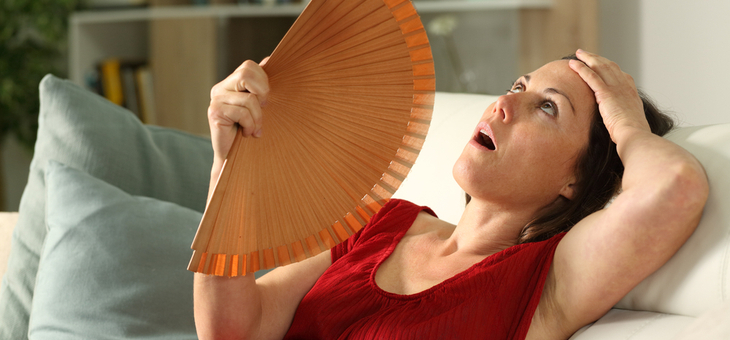Hot flushes, also called hot flashes or vasomotor symptoms, are the most recognisable symptom of both perimenopause and menopause, and are experienced by up to 75 per cent of women.
They typically occur as a feeling of intense heat, which can come on suddenly or slowly. Alternatively, they may be experienced as tingling, a red or flushed face, sweating, burning skin, or even stronger symptoms such as dizziness, chills, nausea, night sweats, pressure in the head or the sensation of the heart beating faster than usual. The latter symptom is called heart palpitations.
Hot flushes can last anywhere from just seconds to 10 minutes, but on average last about four minutes and occur anywhere from every few days to up to several per hour.
Hot flushes are generally not considered to be harmful, but frequent flushing during menopause has, unfortunately, been linked to an increased risk of dementia and heart disease later in life.
Read more: How to relieve a headache
The link is probably not likely to be causative but is instead correlative, as both flushes and the disease risk could stem from the same underlying problem of impaired energy metabolism and insulin resistance.
What causes hot flushes?
The official cause of flushes is not known, but most research points to the brain, specifically to a narrowing of the thermoneutral zone of the brain’s thermoregulatory mechanism.
It’s basically a narrowing of the range of temperature that the hypothalamus considers to be normal – like a touchy thermostat.
Before menopause, the hypothalamus accepts as normal a shift in body temperature of up to 0.4 degrees Celsius, which allows you to step indoors or enjoy a hot drink without your body trying to cool itself with a flush or sweat.
With perimenopause and menopause, even the tiniest shift in body temperature can result in the hypothalamus trying to make a ‘temperature adjustment’ with shivering or sweating.
Read more: Twelve signs of hormone imbalance
The narrowing of the thermoneutral zone is affected by estrogen – not so much by low estrogen but by a fall from high to low. In fact, you’re more likely to experience a narrowing of your thermoneutral zone (and therefore flushes) if you were exposed in perimenopause to high, fluctuating estrogen levels.
In contrast, you may be less vulnerable to hot flushes if you were exposed in perimenopause to (on average) a lower level of estrogen.
Mechanisms by which dropping estrogen narrows the thermoneutral zone include 1) direct effects on the hypothalamus, and 2) alterations in levels of serotonin and adrenaline, which in turn, affect the hypothalamus.
The role of neurotransmitters is why stress management is so important during perimenopause; the more stressed you feel, the more likely you are to flush.
Conventional treatment for hot flushes
Estrogen therapy is the main conventional treatment and is highly effective. It works by stabilising the thermoregulatory mechanism and supporting brain energy. Estrogen works best when combined with progesterone.
Read more: How your hormones change as you age
Progesterone-alone can also relieve hot flushes, especially during perimenopause. It works by calming the brain and reducing adrenaline, thereby stabilising the thermoregulatory mechanism.
You could also try a progesterone cream, understanding that it is a lower dose than a capsule and so might work only for mild symptoms.
Antidepressants are another conventional option and work by lowering adrenaline. They are moderately effective but can, unfortunately, also cause side effects, such as weight gain, reduced libido and an increased risk of osteoporosis.
Diet and lifestyle for hot flushes
Employ the basic action plan, including identifying and reversinginsulin resistance, soothing your nervous system and quitting alcohol.
Movement is particularly helpful, with both strength training and yoga performing well in studies. For example, a recent systematic review found that yoga relieves hot flushes, night sweats and other menopausal symptoms such as anxiety, vaginal dryness and even painful intercourse.
Avoid stimulants or trigger foods, such as alcohol and spicy foods. You may need to observe your pattern of flushes to learn which foods are a problem.
Supplements and herbal medicines for hot flushes
Magnesium and taurine are my top two supplement recommendationsfor hot flushes. Of all my patients who try that combination for hot flushes, approximately half find it’s all the treatment they need.
Of course, many other supplements are marketed for hot flushes but I haven’t found many (or any) to be particularly effective.
One of the more popular herbal medicines is black cohosh, which I don’t prescribe but will discuss briefly.
Black cohosh
Cimicifuga racemosa (black cohosh) is a popular herbal medicine for hot flushes that has undergone several clinical trials with mixed results.
A 2010 meta-analysis concluded it may slightly improve menopausal symptoms, but much of that may be due to the placebo effect.
How it works: Black cohosh does not contain significant amounts of phytoestrogens (despite early claims that it did). Its primary mechanism seems to be that it interacts with serotonin, dopamine and opioid receptors in the brain.
What else you need to know: The exact quantity of the herb depends on the concentration of the formula. A proprietary blend of black cohosh called Remifemin delivers 20mg of a concentrated extract. Because black cohosh is not estrogenic, it carries no known risk for breast cancer or vaginal bleeding.
There were early reports of liver toxicity, but subsequent research has been unable to establish a link. Most experts now conclude that the reports were due to a contaminant and not black cohosh.

This is an extract from Hormone Repair Manual by Lara Briden. Published by Macmillan Australia. RRP $34.99. Available from www.larabriden.com and all good bookstores.
What’s your secret to dealing with hot flushes?
If you enjoy our content, don’t keep it to yourself. Share our free eNews with your friends and encourage them to sign up.
This article contains general information about health issues and is not advice. For health advice, consult your medical practitioner.

